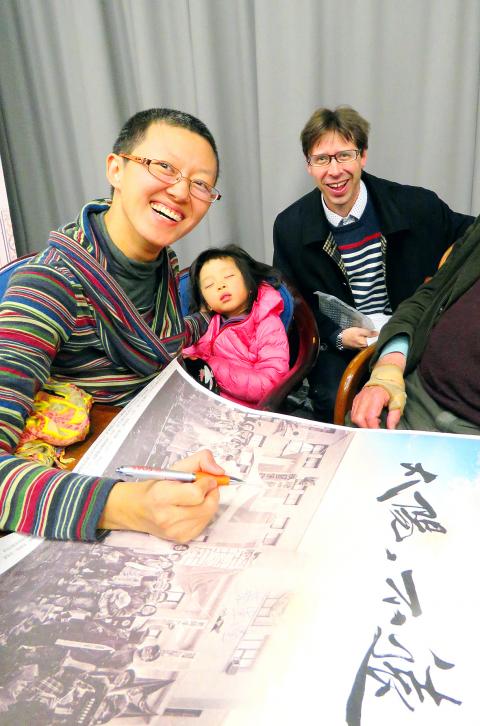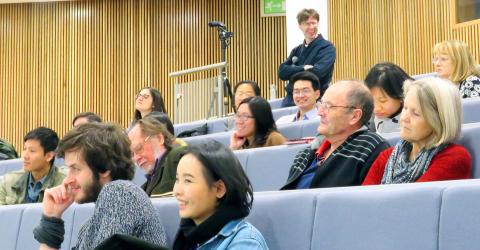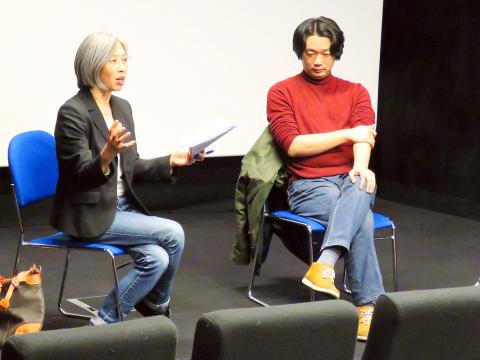For the vast majority of people in Europe, knowledge of the Taiwanese film scene extends no further than the work of director Ang Lee (李安) but a greater appreciation is being sparked by events such as the annual Taiwan Film Week at the Center of Taiwan Studies, part of the University of London’s School of Oriental and African Studies (SOAS).
Director of the Center of Taiwan Studies, Dafydd Fell, has found the medium of film a useful tool to address themes such as politics, modern history, society and economics.
“I teach in a political science department but being in the Taiwan studies community, I get exposed to a range of disciplines, including film. So I often use Taiwanese films in my teaching of Taiwanese politics.”

Photo: Jewel Lo
Fell, who presented the paper Portrayals of Democratic Politics in Taiwanese Film at last month’s European Association of Taiwan Studies Conference in Prague, responded to student interest in Taiwan’s social movements by screening the documentaries Civil Disobedience (公民不服從) and Sunflower Occupation at this year’s Taiwan Film Week in February. After the screenings, which respectively focus on the unrest generated by the visit to Taiwan of Association for Relations Across the Taiwan Strait Chairman Chen Yunlin (陳雲林) in 2008 and the events surrounding the occupation of the Legislative Yuan in 2014, the audience had the chance to take part in a question and answer session with director Chen Yu-ching (陳育青).
“The audiences tend to be quite diverse for the film screening events,” Fell says. “One group will be SOAS students taking our Taiwan courses but others will be non-students who are interested in Asian film, postgraduate students who have a film or Taiwan interest, [students at] other universities, members of the overseas Taiwanese community.”
“When we show social movement-related films then it is quite common for students who were activists in the past, but happen to be studying or working in the UK, to join screenings and they can bring something different to the discussion,” Fell says. “Social movement topics also tend to attract audience members from Hong Kong but also from China.”

Photo: Tony Phillips
Sunflower Occupation is an omnibus featuring different films outlining the progress and aftermath of the Sunflower movement, arguably the most important protest movement in a generation. Some of these look at the movement in its historical and social context, for example, by featuring former leaders of the Wild Lily Movement of 1990 talking about more recent events.
“It is definitely easier to record footage of social movements today,” Fell says. “In fact, in Sunflower Occupation some parts were filmed using phone cameras, such as the Executive Yuan occupation. However, recently a number of documentaries are being released about earlier social movements from the 1980s and 90s. I sense there is a lot of interest in the continuity between these earlier and more recent protest movements.”
“Recently there had been a stereotype that young people in Taiwan were just not interested in politics, thus the ‘Strawberry Generation’ label,” Fell says. “Election rallies tended to be dominated by older audiences. Recent protest movements and election campaigns have undermined that stereotype.”

Photo: Tony Phillips
Also featured in this year’s Taiwan Film Week was the The Losers (廢物), a film about three interconnected characters in Meinong (美濃), a Hakka district in Kaohsiung City, where land is being bought up by developers and estate agents.
The film highlights social issues such as land development, migrant spouse families, challenges to agriculture and drug problems, as well as Hakka culture.
Director Lou Yi-an (樓一安) also traveled to London for the screening and Q&A session.
“The audience response and feedback has been very good over the last few years,” Fell says. “The visiting film directors also enjoy coming to SOAS as the post-screening Q&A and discussion tend to be very informed and lively.”
Londoners will not have to wait until the next Taiwan Film Week for their Taiwanese film fix as the documentaries Gongliao How are you? (貢寮,你好?) and Small Oyster Rock in Kezailiao are scheduled for screenings at SOAS this summer.

April 14 to April 20 In March 1947, Sising Katadrepan urged the government to drop the “high mountain people” (高山族) designation for Indigenous Taiwanese and refer to them as “Taiwan people” (台灣族). He considered the term derogatory, arguing that it made them sound like animals. The Taiwan Provincial Government agreed to stop using the term, stating that Indigenous Taiwanese suffered all sorts of discrimination and oppression under the Japanese and were forced to live in the mountains as outsiders to society. Now, under the new regime, they would be seen as equals, thus they should be henceforth

Last week, the the National Immigration Agency (NIA) told the legislature that more than 10,000 naturalized Taiwanese citizens from the People’s Republic of China (PRC) risked having their citizenship revoked if they failed to provide proof that they had renounced their Chinese household registration within the next three months. Renunciation is required under the Act Governing Relations Between the People of the Taiwan Area and the Mainland Area (臺灣地區與大陸地區人民關係條例), as amended in 2004, though it was only a legal requirement after 2000. Prior to that, it had been only an administrative requirement since the Nationality Act (國籍法) was established in

With over 80 works on display, this is Louise Bourgeois’ first solo show in Taiwan. Visitors are invited to traverse her world of love and hate, vengeance and acceptance, trauma and reconciliation. Dominating the entrance, the nine-foot-tall Crouching Spider (2003) greets visitors. The creature looms behind the glass facade, symbolic protector and gatekeeper to the intimate journey ahead. Bourgeois, best known for her giant spider sculptures, is one of the most influential artist of the twentieth century. Blending vulnerability and defiance through themes of sexuality, trauma and identity, her work reshaped the landscape of contemporary art with fearless honesty. “People are influenced by

The remains of this Japanese-era trail designed to protect the camphor industry make for a scenic day-hike, a fascinating overnight hike or a challenging multi-day adventure Maolin District (茂林) in Kaohsiung is well known for beautiful roadside scenery, waterfalls, the annual butterfly migration and indigenous culture. A lesser known but worthwhile destination here lies along the very top of the valley: the Liugui Security Path (六龜警備道). This relic of the Japanese era once isolated the Maolin valley from the outside world but now serves to draw tourists in. The path originally ran for about 50km, but not all of this trail is still easily walkable. The nicest section for a simple day hike is the heavily trafficked southern section above Maolin and Wanshan (萬山) villages. Remains of